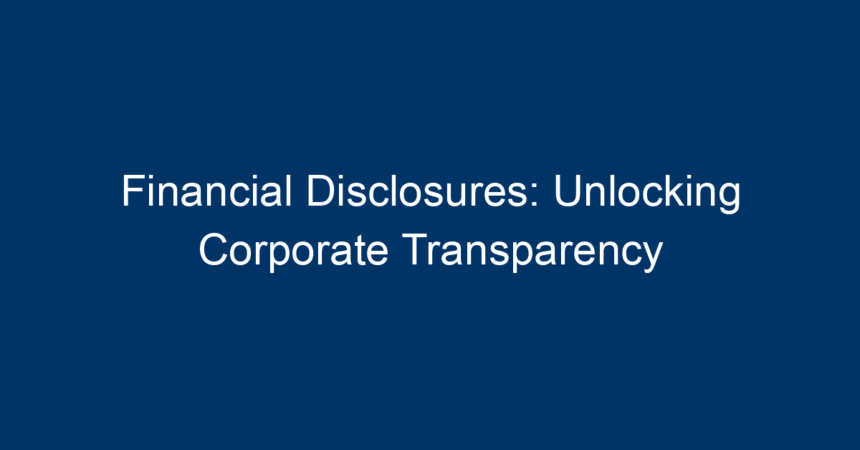In an era marked by increasing demand for accountability, corporate transparency has become a cornerstone of modern business practices. At the heart of this transparency lies financial disclosures—crucial documents that shed light on a company’s financial health and operational practices. Whether you are an investor, a stakeholder, or a member of the general public, understanding financial disclosures is vital for making informed decisions. This article will delve into the significance of financial disclosures, their various forms, the regulatory landscape, and best practices for effective transparency.
Understanding Financial Disclosures
What Are Financial Disclosures?
Financial disclosures refer to the formal communication of a company’s financial information to its stakeholders. These documents provide insights into a company’s performance, profitability, and risk exposure. They serve as a critical tool for stakeholders to assess a company’s financial status and make informed decisions.
The Importance of Financial Disclosures
-
Investor Confidence: Investors rely heavily on financial disclosures to evaluate the potential risks and returns associated with investing in a company. Clear and accurate financial disclosures build trust and encourage investment.
-
Regulatory Compliance: Companies are often required by law to submit financial disclosures, ensuring they meet specific accounting and reporting standards. This compliance protects investors and maintains market integrity.
-
Performance Evaluation: Financial disclosures allow businesses to track their growth and performance over time. Managers use these insights to make strategic decisions and improve operational efficiency.
- Stakeholder Engagement: By providing transparent financial information, companies can engage effectively with their stakeholders, which includes employees, customers, and the community at large.
Types of Financial Disclosures
1. Annual Reports
Annual reports are comprehensive documents summarizing a company’s performance over the fiscal year. They typically include financial statements, management discussions, and analysis of the company’s performance. An annual report not only highlights financial data but also conveys the mission and future outlook of the organization.
2. Quarterly Reports
Unlike annual reports, quarterly reports provide a snapshot of the company’s performance on a quarterly basis. These reports help investors monitor ongoing performance and trends, offering timely insights that can affect investment decisions.
3. Earnings Releases
Earnings releases occur shortly after the end of a fiscal period and communicate a company’s earnings results. These releases are often accompanied by a conference call where company executives discuss the results in detail, providing further context for investors and analysts.
4. SEC Filings
For publicly traded companies, filings with the U.S. Securities and Exchange Commission (SEC) are mandatory. Different forms, such as 10-K (annual report), 10-Q (quarterly report), and 8-K (current events), must be filed by companies and are accessible to the public. These filings are crucial for ensuring regulatory compliance and maintaining corporate transparency.
5. Audit Reports
An independent audit provides an objective review of a company’s financial statements. The audit report typically accompanies annual financial statements and offers assurance on the accuracy of financial disclosures.
The Regulatory Framework Surrounding Financial Disclosures
The Role of Regulatory Bodies
In the United States, the SEC governs financial disclosures for publicly traded companies. Global variations exist, with different regulatory frameworks influencing how disclosures are made. For instance, the International Financial Reporting Standards (IFRS) are used in many countries outside the U.S., facilitating information consistency and comparability.
Legal Implications
Failure to comply with financial disclosure requirements can lead to severe penalties, including fines, legal action, and reputational damage. Companies must prioritize transparency not only for ethical reasons but to avoid facing regulatory scrutiny and penalties.
The Shift Toward Enhanced Transparency
Technological Innovations
With advancements in technology, the way companies present their financial disclosures is changing. Digital platforms allow for real-time updates, making it easier for stakeholders to access information immediately. Technologies such as blockchain are also being explored for secure and tamper-proof financial reporting.
Stakeholder Expectations
In today’s business world, stakeholders, including consumers and activists, expect more than just basic financial data. Companies are increasingly disclosing non-financial information, such as environmental, social, and governance (ESG) metrics. Transparency in these areas can enhance a company’s reputation and drive customer loyalty.
Best Practices for Financial Disclosures
1. Clarity and Consistency
To maintain stakeholder trust, financial disclosures should be consistent and clear. Using simple language, avoiding jargon, and providing detailed explanations or footnotes can help stakeholders better understand the financial data.
2. Regular Updates
Companies should release updated financial disclosures in a timely manner. Regular updates can keep stakeholders informed about ongoing financial health, allowing for better decision-making.
3. Training and Education
Employees responsible for preparing and reviewing financial disclosures should receive regular training. This ensures they stay updated on regulatory changes and best practices, contributing to the accuracy and reliability of the information disclosed.
4. Engage with Stakeholders
An open line of communication with stakeholders can help clarify any questions or concerns regarding financial disclosures. Engaging in discussions through forums or social media can enhance understanding and build trust.
The Future of Financial Disclosures
As businesses evolve in a rapidly changing environment, so too will the landscape of financial disclosures. Increased digitalization and an emphasis on ESG factors are likely to shape future disclosures. Companies must remain adaptable and responsive to changing stakeholder needs.
Embracing Corporate Accountability
As awareness of corporate accountability grows, businesses must acknowledge their duty to provide transparent financial disclosures. By valuing openness over secrecy, companies can cultivate a culture of trust, leading to sustainable success.
Conclusion
Understanding financial disclosures is not merely a compliance exercise but a pathway to unlocking corporate transparency. Companies that prioritize financial disclosure foster trust, enhance their reputations, and ensure compliance with regulatory standards. By adopting best practices and staying attuned to stakeholder needs, businesses can thrive in an environment where transparency is paramount.
For investors, stakeholders, and consumers, being knowledgeable about financial disclosures can empower better decision-making, enabling them to engage more effectively with the corporate entities that impact their lives. As we move toward a more transparent business landscape, the ability to navigate financial disclosures will be an invaluable asset.




